
17 minute read
Air Power: Resolute in Blue Glory
from AEROMAG ASIA
by Aeromag
Chief of the Air Staff Air Chief Marshal Rakesh Kumar Singh Bhadauria PVSM AVSM VM ADC tells Aeromag Asia how the Indian Air Force has comprehensively scaled up its combat capability in response to the evolving threat matrix in the region, to fight across domains over the entire spectrum of warfare. A special salute to the Force on its 88th Foundation Day.
Aeromag Asia: Air Chief Marshal Bhadauria, what was your resolve as you paid your tribute to the indomitable valour and sacrifice of the nation’s warriors on the Kargil Vijay Diwas, in the backdrop of the evolving threat matrix in the region and security challenges in the high-altitude forward bases in eastern Ladakh?
Advertisement
Chief of the Air Staff: Kargil Vijay Diwas is a befitting tribute to the indomitable spirit of the Indian soldiers who surmounted all odds in the line of duty, protecting the Nation at all costs. The IAF was provided a unique opportunity in 1999 as it was called into operations in support of our ground forces. We innovated to arrive at weapon solutions and formulated tactics that allowed aircraft operations at high altitude. It was also the first time that our fighters dropped Laser Guided Bombs in an operational environment. LGBs and GPS aided bombing were extremely successful and pivotal in evicting the intruders from their dug in positions. The experience of Kargil operations has held us in good stead with consolidation of capabilities in later years that can today be brought to bear for operations in high altitude terrain. Our resolve is to modernise and build our capability to attain and maintain a combat and technological edge over our adversaries.
As the CAS who has flown the Rafale jet among a varied array of 26 different PVSM AVSM VM ADC types of fighter aircraft and commanded the Jaguar Squadron as well as the Flight Test Squadron at the Aircraft & Systems Testing Establishment, what’s uppermost in your mind when you speak of enhancing our operational capability?
Our strategic priority is to ensure that we operate home grown systems backed by an industrial ecosystem with expertise in cutting edge technology. Advantage over our adversaries in the long run is possible only if such capability is driven domestically. Training and Infrastructure are also critical capability enhancers that need constant focus. If I look at the near future, the domain of Space is
Air Chief Marshal Rakesh Kumar Singh Bhadauria
gaining increased significance. While we are currently putting in action plans to induct more ground and air borne sensors and combat aircraft, development of space
based assets, information superiority and capabilities in this domain will also be a focus area for the IAF.
You speak of the potent combination of the Su-30 MKI and the Rafale operating together, while embracing emerging fifth generation technologies and strategic capabilities. How daunting is the challenge of integrating and operating existing assets, contemporary combat jets, mission critical systems and advanced platforms?
The IAF has many decades of experience in operating systems with different countries of origin, in addition to those designed within the country. We have adapted technologies and evolved practices to meet our requirements. Most importantly, IAF’s Integrated Air Command and Control System (IACCS) is fully operational and is already in the process of integrating the airborne data link with the IACCS. This network centric operations capability allows us to effectively employ our combat assets. Our procedures cater to integration for concerted operations. Latest inductions like the Rafale and LCA Mk 1 Tejas aircraft, LRSAM, Arudhra and Aslesha radars, SDR etc will be integrated in an optimal way to meet our induction / acceptance standards, training schedules and op employment procedures.
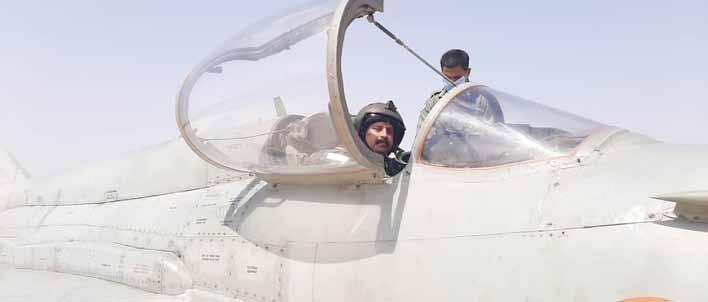
In the midst of the unrelenting devastation and economic fallout of the COVID-19 pandemic, how optimistic are you about smart budgeting with regard to procurement of frontline fighter jets and missile systems, mid-life upgrade of legacy aircraft and funding indigenous projects in aerospace?
We have re-prioritised our critical requirements in procurements and upgrades of aircraft and weapons to meet Op tasks over this decade.
A priority list and smart budgeting will help meet the assigned tasks. IAF has already put in place several measures that would control our revenue expenditures without affecting our operational capability. It should be appreciated that the cash outflow for major capital projects gets extended over a long period and as such, we hope that the current crisis is contained and we will embark on a path of quick economic recovery.

What is the scope of Indian Air Force involvement in the Atmanirbhar Bharat Abhiyan interface between the private sector and public sector Defence establishments, especially with regard to LCA MkII and AMCA, TejasMk 1 and MkIA?
The role of the IAF has been integral to the Tejas programme. We have been in constant interface with Defence research institutes and PSUs with regard to our requirements and specifications that led to its development.
IAF has been strongly advocating an increased role of private sector in aerospace manufacturing. The big projects like LCA variants and AMCA
will certainly involve the Public and Private sector in equal measure. In fact, the private sector will have increasingly greater role in design and development of defence systems / sub-systems and in some cases, to even be the lead integrator of major platforms and combat systems. The new DAP 2020 promotes Development cum Production Partner or DCPP model for defence projects and IAF fully supports it. In addition to the big capital acquisition projects, IAF is already progressing a large number of projects under Make-II, Technology Development Fund (TDF) and iDEX schemes. Equally important are IAFs’ own efforts to indegenise a very large number of spares and consumables for our existing aircraft and systems. Most of these indigenisation efforts are with the private sector.
Now that you have presided over the formation of the second Tejas Squadron, the Flying Bullets, last May, in the initial Covid lockdown period, and the Rafale jet has been inducted into the IAF, are new contingencies going to affect your induction schedules and squadron strength?
First five Rafales have been inducted into IAF on August 20. Induction of balance Rafale is on schedule. We expect more number of LCA aircraft to start inducting at Sulur soon. I am confident that HAL armed with the experience of having operated in a pandemic, will be able to ramp up its production rate and ensure timely deliveries of balance aircraft. Induction of 83 LCA MK 1A will commence in three to four years and we are hopeful that HAL will ensure accelerated delivery of these aircraft.
In the next three to four years period we will see the Rafale and LCA Mk1 squadrons operating in full strength, along with the additional Su-30 MKI and Mig-29 aircraft procured to add to the current fleet strength. The induction of the 83 LCA Mk1A will commence soon thereafter and we expect that the full complement of 83 aircraft should get delivered at a faster rate.
Finally, is the Mission Gaganyaan training programme that IAF has been overseeing on track? Could you give us an update?
The IAF pilots selected for the Gaganyaan programme have been undergoing training under the aegis of ISRO in Russia. The programme is well coordinated and orchestrated as part of national effort. The IAF pilots are in good health and good progress has been made in their training. I am sure Gaganyaan Programme will be a great success and the nation shall witness Indian Gagannauts in Space inside Indian Space Capsule launched by Indian rockets.
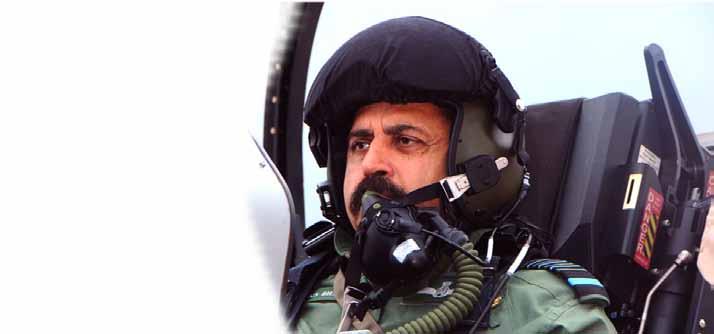
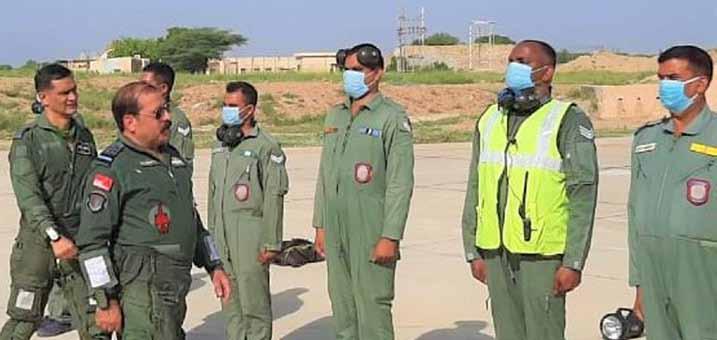
IAF ‘Looks East’ The Quest for Air Supremacy along the Himalayas
“Air power will be a crucial enabler for our victory in any future conflict. It is imperative that the IAF obtains and maintains technological edge over our adversaries.” These words by the Indian Air Force chief Air Chief Marshal (ACM) RKS Bhadauria during a talk the Centre for Air Power Studies in September has highest ever relevance considering the IndoChina standoff. The recent induction of several platforms including the Rafales, C-17s, Chinooks and Apaches had provided the IAF with substantial tactical and strategic capability enhancement along the Indo-China border which has been witnessing heightened military situation over the few months. IAF has been showing off its night-flying capability in Ladakh, with fighter jets like the MiG-29 and the Sukhoi-30 carrying out round-the-clock flying. However, even as the government asserts that IAF is fully prepared for a two-front war, the concerns of the ageing assets of IAF against the almost double-sized air fleet of China are real. Because if the ‘Dragon beyond the Himalayas’ decides to breath out fire over the ice-capped mountains, India’s air superiority will undoubtedly be put to the toughest test ever. Here, Aeromag analyses the capabilities of Indian Air Force (IAF) and the immediate importance of adding to its airpower through faster indigenization in the background of prevailing standoff between India and China along the border.
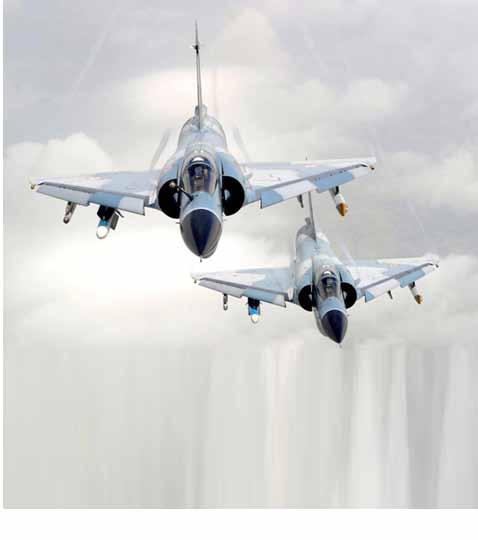
The superiority in air power is the most prime factor in deciding the outcome of a modern conventional war. If a country loses the war in the air, it will lose the war and it will lose quickly. Supreme air power has always created superpowers in history. Though the methods might have changed over time, the need for air supremacy never goes away.
In the case of India, now is the time to validate its aerial supremacy especially along the Himalayas, where the Chinese are increasing their presence on land and air due to the Sino-Indian border dispute. The Indian Air Force (IAF) is the fourth biggest air force in the world with proven combat power of man and machine. However, with China’s People's Liberation Army Air Force (PLAAF) having created an air fleet that is nearly double the size of the IAF’s ageing fleet, the situation demands India to recheck the size and operational readiness of IAF assets. Hence India needs to build its deterrence capability by modernizing and expanding the IAF—enough for China to see the futility of forcing a military solution to the Sino-Indian border dispute.
IAF’s ‘Look East’ plans
Over the last one year the standoff between the two countries along the Line of Actual Control (LAC) has been the worst ever since the IndoChina War in 1962. China was hardly in a position to use its air power to influence the ground battle in 1962 and the IAF had upper hand as China’s offensive air capabilities in the Tibetan region were practically nonexistent. But that was more than half a century ago and now if China initiates another military conflict along LAC, it can and will make full use of its air power in a bid to force the outcome in its favour once again.
India is anticipating China’s aerial attempts and has rightly asked IAF to ‘Look East’ keenly unlike the past when the focus was mainly on the western adversary. Till very recently, there were no Surface-to Air Missile (SAM) units or credible radar units east of the 82 degree longitude in the Indian side. The entire eastern command of the IAF has based its war plans on the mobility of Air Defence assets, which were to be brought from the western sector during hostilities. The effectiveness of this plan was never put to test in totality. But now it is altogether a different story and the IAF is on highest-ever alert with most of its sophisticated assets and weapons, including the newly inducted Rafales, having deployed in the region. Besides, combat power, IAF with a key role in providing support to the troops to LAC as India is strengthening its presence in the region.
How strong is the IAF?
The IAF is a modern, technology-intensive force that has kept pace with the demands of contemporary advancements to be counted amongst the foremost powerful air forces in the world. But considering the present military developments in the region the question would be how strong IAF is compared to China’s People’s Liberation Army Air Force (PLAAF). The answer is that the PLAAF has a quantitative edge but IAF will be more than able to hold its own.
The PLAAF is stronger compared with the IAF in terms of fleet and strategic inventory, but the IAF deploys more reliable platforms and strategic bases, combined with

experienced troops. PLAAF is the second biggest air force in the world whereas IAF is the fourth largest. PLAAF has an inventory of more than 2,000 combat aircraft, which is more than double the IAF’s 900 combat aircraft. PLAAF has a long-range strategic bomber fleet and holds more strategic assets such as airborne warning and control system (AWACS) aircraft and combat drones compared with the IAF.
But when it comes to effectiveness and combatreadiness of men, IAF pilots possess more hands-onexperience in high-altitude combat missions that PLAAF’s and the strategic location of bases near the LAC ensures uninterrupted support for India’s aerial assets. Moreover, the combat-proven aerial platforms such as AH64E Apache and CH-47F Chinook are reliable during conflicts and the modern fleet of transport aircraft enables rapid transfer of equipment and supplies to the areas of operation.
Fighter Fleet
The PLAAF has around 600 fourth-generation fighters including J-10B/C, J-11B, J-16, and Su-30. It has also started building fifth-generation fighters such as J-20 and FC31/J-31. Although the PLAAF has started inducting J-20, which has stealth features, it is said to be not superior to IAF Rafale, a 4.5-generation aircraft inducted recently. Like the IAF chief said the induction of five Rafale fighters will enable the IAF to maintain air superiority over China’s J10, J11, and Su-27 fighter jets. Rafale is armed with Meteor very long-range and MICA beyond visual range (BVR) air-to-air missiles, which could give superiority over Chinese aerial assets. India is set to get another 31 Rafales in the coming years.
The Rafale can fly at speeds of 1.8 mach (2,222.6km per hour) and it has a range of 3,700 km. It has multidirectional radar which can detect 40 targets at the same time in a range of over 100 kms. It has Spectra, an integrated defence aid system which can jam or counterjam enemy radar signals. The aircraft has cannon that can fire 2,500 rounds per minute.
Rafale will have the ability to take off from high altitude airbases like Leh on a 'cold start' - for quick reaction deployment. Rafale is going to boost the IAF's capabilities as it comes loaded with 13 India specific enhancements.
IAF’s prime most air superiority fighter is the Russian made Sukhoi Su30MKI which can perform air-to-ground strike missions. There are more than 270 Su-30MKIs in the IAF and they form the backbone of IAF fighter fleet. Moreover the twin-seater, twin-engine multirole combat aircraft can fire the supersonic missile BrahMos. BrahMos-armed Sukhoi-30 MKI, which need not have to cross the border anymore to destroy enemy’s deep assets, is a lethal weapon of IAF.
The Sukhoi Su-30MKI has 2500 km/hr (Mach 2.35) and has a maximum takeoff weight of 38,800 kg. The Su-30 MKI aircraft is capable of being refuelled by an Air to Air refuelling aircraft or by another Su-30 MKI aircraft carrying a buddy refuelling strap on pod. Su-30MKI multi-role fighter-bomber is one of the best 4 generation aircraft currently available.

So, the combination of Rafale and Su-30 MKI along with the BrahMos will be a gamechanger as these fighter jets will extensively enhance the attacking capabilities of the IAF. IAF is also fielding HAL Tejas fourth-generation multi-role light fighters to replace its ageing MiG21 interceptor aircraft.
IAF also has more than 50 French multi-role aricraft Mirage 2000 and 106 strike aircraft Jaguar in service. The Russian made Air Superiority aircraft MiG 29, ground attack aircraft MiG 27 and Interceptor/ Multi-role aircraft MiG 21 are also there in the fleet.
Lack of strategic bomber fleet
The PLAAF has a dedicated bomber force that comprises the H-6 Badger, which is a long-range aircraft that can carry six land-attack cruise missiles (LACMs). It could provide the PLAAF with a long-range, precision-strike capability to target any part of India. But the IAF has no strategic bomber fleet and there are limited options to deploy its AN-32 transport aircraft and multi-role fighters in bombing missions.
Early warning aircraft
The PLAAF has around 20 AWACS and airborne early warning and control (AEW&C) aircraft compared to five aircraft of IAF. The KJ-2000 Mainring (based on Ilyushin Il-76), KJ-200 Moth (Shaanxi Y-8), and KJ-500 (Shaanxi Y-9) are China’s force multipliers amplifying the capabilities to detect, track, and target threats. The I AF currently operates indigenously developed DRDO AEW&C system, which is based on the Embraer ERJ 145 aircraft, and the EL/W-2090 Phalcon AEW&C installed on the Beriev A-50 platform.
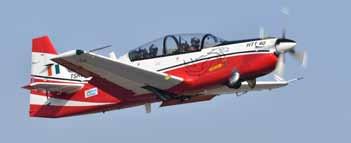
IAF has edge Transport aircraft fleet
IAF has the state-of-the-art strategic air lifters, including the C-17 and C-130J, to ensure rapid transfer of equipment and supplies to airbases near the LAC, which is the need of the hour for ground forces on the battlefield. The C-17 Globemaster III, C-130J-30, Ilyushin Il-76, Antonov An-32, and Dornier Do 228 aircraft form part of the IAF’s transport aircraft inventory. The PLAAF’s comparatively smaller fleet of strategic airlift assets includes Y-20 large transport aircraft and Russian-made Il-76 aircraft.
Advanced rotorcraft fleet
India is a strong contender to China with its advanced helicopter fleet. The IAF’s CH-47F Chinook, Mil Mi-26, Mil Mi-8, Mil Mi-17, Mi-17 1V, and Mi-17V 5 are intended for heavy and medium-lift strategic and utility roles while HAL Light Combat Helicopters (LCH) and HAL Rudra attack helicopters are dedicated for combat missions.
The recently inducted Boeing AH-64E Apache attack helicopters will enable the IAF to perform day/night, all-weather attack missions especially in rugged mountain regions of Indo-China borders. The PLAAF operates the WZ-10 attack helicopters, Mil Mi-8, and Harbin Z-9 utility helicopters, and Changhe Z-8 transport/utility helicopters.
UAVs and SAMs
The IAF has a smaller UAV fleet compared to PLAAF’s that includes IAI Searcher II and IAI Heron for reconnaissance and surveillance missions. The PLAAF operates Yunying (CloudShadow) armed reconnaissance unmanned aerial vehicles (UAVs), Gongji 1 armed intelligence, surveillance and reconnaissance (ISR) UAVs, CH-4 and CH-5, and Yilong (Wing Loong) series of unmanned aircraft, which can carry two or more air-tosurface guided munitions. A UAV fleet has the advantage in conducting sorties and strikes near the borders with no risk of damage to their manned aircraft and crew.
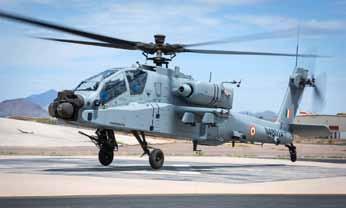
Surface-to-air missiles
The PLAAF has SA-20 battalions imported from Russia and indigenouslyproduced CSA-9 (HQ-9) battalions, making it one of the world’s largest inventories of advanced long-range surface-to-air missile (SAM) systems. With the S-400 Triumf SAM system in its arsenal, the PLAAF can intercept incoming aerial targets at a range of 400km, ensuring superior air defence capabilities against India.
The IAF’s SAM inventory includes S-125 Pechora, 9K33 Osa-AK, 9K38 Igla-1, Akash, and SPYDER missile defence systems. Though India has ordered the S-400 Triumf SAM system the delivery is yet to be made.

Need for Fleet Addition/ Upgrade and its Challenges
The numbers of IAF fighter squadrons had dropped to 29 from a sanctioned strength of 42. Soon this will decrease even further to around 25 squadrons, as 4-5 squadrons of its 100-odd legacy MiG-21 ‘BIS’ ground-attack fighters will retire. The IAF chief
Bhadauria has conceded that the IAF would be unable meet its goal of operating 42 combat squadrons by 2030, but would manage 36-38 squadrons by then.
But the funds, technological input and industrial capability needed for these additional assets will be a challenge for India considering the budgetary constraints due to the COVID-19 pandemic. The additional 320-odd fighter types would cost upwards of $ 45 billion, or around 68%, of the annual defence budget of $65.9 billion for the fiscal year 2020-21.
India ordered 36 Rafale jets from France in a deal worth Rs 59,000 crore in September 2016 and only five were delivered.


IAF Indigenisation
IAF is looking at close to 450 ‘Make in India’ aircraft of various types in the next 10-15 years. IAF would sign a deal with HAL for an additional 83 upgraded Tejas M1A fighters. To bridge the shortfall of fighters, till the indigenously Advanced Medium Combat Aircraft (AMCA) joins the fleet 2029 onwards, the focus will be on procurement of 114 Multirole Fighter Aircraft (MRFA).
Bhadauria said that it is the best time for 'indigenous production' of these aircraft since industries were responding and coming up with solutions to the challenge of delivering them. He also talked about the possibility of a Joint Venture (JV) in developing fighter jet aeroengine in India that will potentially set forth a new era of aerospace in India.



